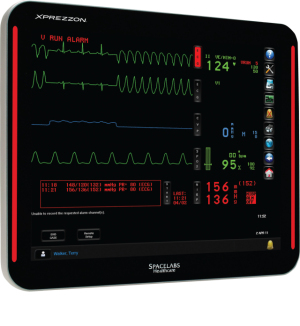by
Sean Ruck, Contributing Editor | July 20, 2011
From the July 2011 issue of HealthCare Business News magazine
Hospitals have more technology than ever before and alarm fatigue is one unfortunate drawback that has arrived with it. Alarm fatigue means a nurse, experiencing sensory overload, either grows complacent when hearing an alarm, possibly assuming someone else will handle it; becomes so frustrated with a false alarm that he or she shuts it off or lowers the volume; or manages to mentally file it away as background noise, ignoring it altogether.
The label “alarm” fatigue is slightly misleading, since it’s not just physiological patient alarms contributing to the noise. In addition to the warnings (both real and nuisance) given off by ventilators and IV pumps, other devices like call bell systems and even cell phones or pagers add to the cacophony. And there’s yet another sound being added — public outcry.
The human toll
Alarm fatigue takes its toll on hospital staff. A false or nuisance alarm can be distracting and may lead to mistakes in patient care. It can also be stressful to patients trying to rest and recover from surgeries or illness. The constant concern that a vital alarm might go off can also cause stress and anxiety for nurses worried about missing an event that needs immediate attention. And there’s legitimate cause for concern.
Mark Meyers, senior
associate of the
applied solutions group,
ECRI Institute
Earlier this year, The Boston Globe published an investigative report about the hazards of alarm fatigue. The Globe tapped ECRI Institute, a nonprofit organization that researches the best approaches to improving patient care, to review the Food and Drug Administration’s database of adverse events involving medical devices. From that information, it was determined that a total of 216 deaths were, in part, due to alarm problems. The problems included an alarm’s volume turned down so low as to be inaudible; equipment being used improperly; alarm speakers being taped over to somewhat mute the sounds; and, in some cases, nurses admitting that the alarm warnings just became background noise that was ignored. Manufacturing issues were cited in just eight cases. Experts at ECRI believe the actual number of deaths due to alarm issues is much higher, but hospitals may underreport the causes.

Jose Morillo
ALARM FATIGUE. AN ENEMY EASY TO FIGHT
July 23, 2011 11:10
Never until now, nurses and medical personal was as expose to alarms detectors as now. Multiparameter monitors make possible measure almost any bilogocal parameter and asign, even automatically, alarms parameters for each one.
Two big problems are still present with alarms: 1.- Misadjusted alarms parameters that make it activate all time. 2.- Electrode, Transducers misconnections.
Both problems have solution. A correct alarm adjustment must consider the normal fluctuation of any parameter, human body is not a swiss clock. We must adjust alarms to levels that indicate a warning condition. It will mean a wider window of adjustment and a significative reduction of flase alarms (those alarms that haven't a clinical importance.
AN intelligent algoritm design can make monitors evaluate the alarm condition in a scale. Rarely the human parameters are independ one each other. Often a HR is follow or anteceded by an Arterial pressure variation, SpO2 or temperature variation. An "intelligent" monitor can evaluate, for example, HR from ECG and SpO2 at the same time two difference between an emergency condition and a loose transducer or electrode. it can consideer HR variation vs. Artery Pressure and/or SpO2 to determine a danger trend and launch a real alarm.
An intelligent ECG monitor can use as few as just 2 electrodes. Basically a ICU monitor is following Heart Rate, waveshape has no alarm itself. All alarm condition mean a frequency variation, soo 2 electrode are enough to check it. Always in case of doubt an ECG is maded with a full 12 electrodes ECG.
SpO2 and NIBP can be acopled. SUre a significative wave amplitude variation on SpO2 can mean an Arterial pressure variation. Monitor can launh a NIBP measurement to confirm BEFORE launch an alarm.
Parameter inter relations have no limits. A doctors and Biomedical team can make a new generation of Intelligents monitors.
Go ahead!
to rate and post a comment